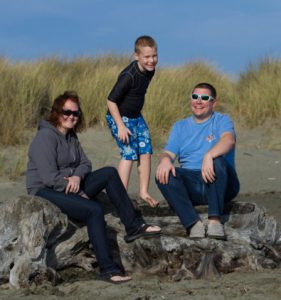
My first Mother’s Day was in 2004. I anticipated sleepless nights and lots of happiness around the arrival of my first son, Adam, due in early May. Instead, there were potted plants and sympathy cards and a single white rose in a blue vase after my son was stillborn just before midnight on April 24.
I’d gone in for a regular 38 week checkup, and there was no heartbeat. It’s the only vist my husband didn’t attend, since we believed what everyone had said, “Once you’re through the first trimester, everything’s fine.” I went directly from the doctor’s office to the labor and delivery floor, where I had to start the process to deliver my baby who was not alive. The medical team started to induce my labor, but then had to stop once their attention shifted to some emergency C-sections. I was left to try to sleep, while around me women were delivering their living, breathing babies. In the morning, the induction process was started again.
After Adam was born, I was reluctant to hold him. Every day, I am thankful for the nurse who encouraged me to take him in my arms. Now I wish I had taken more time with him. He is the child who made me a mother, and yet celebrating Mother’s Day was the last thing on my mind that May.
I was left with a million questions. How could this happen? What did I do wrong? Why haven’t I heard of this happening?
I know that in much of the world, stillbirth results from women lacking access to skilled medical care during labor and delivery. In fact, one million women a year begin labor with a healthy fetus, but deliver a dead baby. Global efforts to improve health systems will reduce the number of stillbirths just by providing women access to care.
But that won’t impact the situation in the United States, where a family experiences a stillbirth every 21 minutes. In most cases, the family is left wondering “Why?” as there is frequently no obvious explanation for what causes a baby to be stillborn. If autopsies were performed regularly, we might know more. But, autopsies are expensive and rarely covered by insurance. As a result, the epidemic of stillbirth fades to the background; at best overlooked, at worst ignored. Most people don’t want to hear about your dead baby; it’s an uncomfortable topic to discuss, but this just leaves parents feeling even more alone and isolated.
Stillbirth in the U.S. is now about 10 times more frequent than SIDS, but there is much greater awareness of SIDS. That heightened awareness drove scientists to research, and the result has been the very successful “Back to Sleep” campaign that has dramatically reduced the number of infant deaths from SIDS by about 50%. It’s time for stillbirth to receive the attention and research it needs.
There are a growing number of parents who want to honor their stillborn children through advocacy and raising awareness. Since Adam’s death, I’ve met far too many parents who, like me, had to bury their children before they took their first breath. Several of us learned of the work of the Global Alliance to Prevent Prematurity and Stillbirth (GAPPS) at Seattle Children’s, and formed the Stillborn, Still Loved guild. We support the work of GAPPS, especially in raising awareness of stillbirth and the need for more research.
Mother’s Day is coming up. What I want for Mother’s Day is for scientists to do the work to explain why stillbirth happens. Find a biomarker that can identify the women at risk. Develop an intervention that will prevent it. To funders, please make this a research priority. To everyone, raise your voice and challenge researchers to find the answers.
On Mother’s Day, I will enjoy the day with my living son, and we will remember his brother, Adam, who I buried 12 years ago. The white rose in a blue vase that my mother gave me for Adam’s birthday this year will be on the table next to us.
Keli Hansen is a mother of two sons and a co-founder of the Stillborn, Still Loved guild at Seattle Children’s. She lives in Seattle and is a pediatric nurse practitioner.

